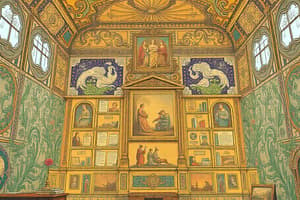Podcast
Questions and Answers
What is a disadvantage of having a highly centralized organizational structure?
What is a disadvantage of having a highly centralized organizational structure?
- Higher motivation among employees
- Improved decision-making agility
- Greater flexibility in response to challenges
- Overloaded management and loss of control (correct)
Which mechanism is described as having a low cost but being effective only to a certain extent?
Which mechanism is described as having a low cost but being effective only to a certain extent?
- Task forces
- Teams
- Integrating roles
- Direct contacts (correct)
According to the Contingency Theory, what factor does NOT influence the design of an organization's structure?
According to the Contingency Theory, what factor does NOT influence the design of an organization's structure?
- Uncertainty of the environment
- Technology used
- Size of the organization
- Color of the company's logo (correct)
What solution was proposed for improving coordination issues in the Nice Bottles case?
What solution was proposed for improving coordination issues in the Nice Bottles case?
In the context of relational mechanisms, which option involves a group addressing a specific problem for a limited time?
In the context of relational mechanisms, which option involves a group addressing a specific problem for a limited time?
What was a significant issue identified in the FIAT case analysis?
What was a significant issue identified in the FIAT case analysis?
What does introducing standardization in a production process aim to achieve?
What does introducing standardization in a production process aim to achieve?
What type of interdependence was cited as a problem in the organization structure of Nice Bottles?
What type of interdependence was cited as a problem in the organization structure of Nice Bottles?
What is a key advantage of divisional structures in organizations?
What is a key advantage of divisional structures in organizations?
What is a disadvantage of having a divisional structure in an organization?
What is a disadvantage of having a divisional structure in an organization?
How does a divisional structure enhance market responsiveness?
How does a divisional structure enhance market responsiveness?
Which of the following describes the primary focus of a divisional structure?
Which of the following describes the primary focus of a divisional structure?
What is a characteristic of the multidivisional approach within a divisional structure?
What is a characteristic of the multidivisional approach within a divisional structure?
What is one of the challenges faced by organizations utilizing a divisional structure?
What is one of the challenges faced by organizations utilizing a divisional structure?
What is a consequence of removing dependencies between divisions in a divisional structure?
What is a consequence of removing dependencies between divisions in a divisional structure?
Which level of management is primarily responsible for overseeing and integrating activities between different divisions?
Which level of management is primarily responsible for overseeing and integrating activities between different divisions?
What is the primary role of the product owner in an agile team?
What is the primary role of the product owner in an agile team?
What characterizes a simple structure in an organization?
What characterizes a simple structure in an organization?
Which of the following is a disadvantage of an entrepreneurial structure?
Which of the following is a disadvantage of an entrepreneurial structure?
In an artisan structure, which statement is true about the organization's head?
In an artisan structure, which statement is true about the organization's head?
How does a matrix structure combine elements from other structures?
How does a matrix structure combine elements from other structures?
What key change does an agile coach help facilitate in an organization?
What key change does an agile coach help facilitate in an organization?
Which structure is known to be less efficient but more responsive to customer needs?
Which structure is known to be less efficient but more responsive to customer needs?
What is a characteristic of a functional structure as organizations grow?
What is a characteristic of a functional structure as organizations grow?
What describes standardization in organizational processes?
What describes standardization in organizational processes?
What is a potential disadvantage of organizational norms?
What is a potential disadvantage of organizational norms?
What is the primary difference between centralized and decentralized authority?
What is the primary difference between centralized and decentralized authority?
Which of the following best describes mutual adjustment in organizational settings?
Which of the following best describes mutual adjustment in organizational settings?
Which aspect is NOT typically associated with standardization?
Which aspect is NOT typically associated with standardization?
What role does socialization play in an organization?
What role does socialization play in an organization?
Which of the following is an advantage of a centralized authority in an organization?
Which of the following is an advantage of a centralized authority in an organization?
What is a common characteristic of norms in organizations?
What is a common characteristic of norms in organizations?
What is one of the primary advantages of a multidivisional structure?
What is one of the primary advantages of a multidivisional structure?
What is a disadvantage of a product team structure?
What is a disadvantage of a product team structure?
In a matrix structure, what is a key feature that distinguishes it from other organizational structures?
In a matrix structure, what is a key feature that distinguishes it from other organizational structures?
What characteristic defines a meta-organization?
What characteristic defines a meta-organization?
Which of the following best describes the purpose of a matrix structure?
Which of the following best describes the purpose of a matrix structure?
How does decision-making in a product team differ from a multidivisional structure?
How does decision-making in a product team differ from a multidivisional structure?
What is a common challenge faced by organizations with a tall structure?
What is a common challenge faced by organizations with a tall structure?
What does the term 'transfer pricing' refer to in the context of division competition?
What does the term 'transfer pricing' refer to in the context of division competition?
What is the main barrier to change at the individual level?
What is the main barrier to change at the individual level?
In Lewin's Change Model, what must be minimized to facilitate change?
In Lewin's Change Model, what must be minimized to facilitate change?
What characterizes the approach of Total Quality Management?
What characterizes the approach of Total Quality Management?
What is the purpose of the 'refreezing' stage in Lewin's Change Process?
What is the purpose of the 'refreezing' stage in Lewin's Change Process?
What was a driving force for change at ING?
What was a driving force for change at ING?
How did ING's approach to roles change during its restructuring?
How did ING's approach to roles change during its restructuring?
Which approach focuses on jointly optimizing technical changes with social norms?
Which approach focuses on jointly optimizing technical changes with social norms?
What indicates that ING underwent revolutionary change?
What indicates that ING underwent revolutionary change?
Flashcards
Social Interdependencies
Social Interdependencies
Groups form to provide mutual support, social interaction, and effective communication within an organization.
Standardization
Standardization
A method of coordinating activities before they happen by establishing predefined rules and processes.
Standard Process
Standard Process
Defined sequence of steps to be followed in a specific activity.
Standard Output
Standard Output
Signup and view all the flashcards
Standard Skills
Standard Skills
Signup and view all the flashcards
Norms
Norms
Signup and view all the flashcards
Centralized Authority
Centralized Authority
Signup and view all the flashcards
Decentralized Authority
Decentralized Authority
Signup and view all the flashcards
Contingency Theory
Contingency Theory
Signup and view all the flashcards
Uncertainty of the Environment
Uncertainty of the Environment
Signup and view all the flashcards
Liaison Role
Liaison Role
Signup and view all the flashcards
Task Force
Task Force
Signup and view all the flashcards
Team
Team
Signup and view all the flashcards
Integrating Role
Integrating Role
Signup and view all the flashcards
Divisional Structure
Divisional Structure
Signup and view all the flashcards
Divisional Structure Specialization
Divisional Structure Specialization
Signup and view all the flashcards
Product Division
Product Division
Signup and view all the flashcards
Multidivisional Structure
Multidivisional Structure
Signup and view all the flashcards
Centralized Functions
Centralized Functions
Signup and view all the flashcards
Self-Contained Divisions
Self-Contained Divisions
Signup and view all the flashcards
Levels of Management in Multidivisional Structure
Levels of Management in Multidivisional Structure
Signup and view all the flashcards
Integration of Divisions
Integration of Divisions
Signup and view all the flashcards
Functional Structure
Functional Structure
Signup and view all the flashcards
Matrix Structure
Matrix Structure
Signup and view all the flashcards
Entrepreneurial Structure
Entrepreneurial Structure
Signup and view all the flashcards
Artisan Structure
Artisan Structure
Signup and view all the flashcards
Autonomous Squads
Autonomous Squads
Signup and view all the flashcards
Tribes and Squads
Tribes and Squads
Signup and view all the flashcards
Going Agile
Going Agile
Signup and view all the flashcards
Product Team Structure
Product Team Structure
Signup and view all the flashcards
Communication Problems in Tall Structures
Communication Problems in Tall Structures
Signup and view all the flashcards
Bureaucratic Costs
Bureaucratic Costs
Signup and view all the flashcards
Transfer Pricing
Transfer Pricing
Signup and view all the flashcards
Multidivisional Matrix
Multidivisional Matrix
Signup and view all the flashcards
Meta Organization
Meta Organization
Signup and view all the flashcards
Organizational Resistance
Organizational Resistance
Signup and view all the flashcards
Group Resistance
Group Resistance
Signup and view all the flashcards
Individual Resistance
Individual Resistance
Signup and view all the flashcards
Lewin's Force Field Analysis
Lewin's Force Field Analysis
Signup and view all the flashcards
Socio-Technical Change Approach
Socio-Technical Change Approach
Signup and view all the flashcards
Total Quality Management (TQM)
Total Quality Management (TQM)
Signup and view all the flashcards
Business Process Reengineering (BPR)
Business Process Reengineering (BPR)
Signup and view all the flashcards
Flexible Teams
Flexible Teams
Signup and view all the flashcards
Study Notes
Stakeholders Ethics
- Knowledge and decision making are key components of stakeholder ethics.
- Designing organizations presents challenges related to organizational culture and change.
- Organizational structures are also a significant part of this topic.
What is an Organization?
- A group of people coordinated to achieve value creation.
- They're linked to the external environment.
How do Organizations Create Value?
- Providing services or selling products.
- Transforming resources from input to output.
- Value creation occurs in three stages: input, conversion, and output
Organizational Environment
- The set of forces beyond an organization's boundaries that affect its ability to acquire and use resources for value creation.
Different Ways to Create Value
- External resources approach: A company's ability to secure scarce and valuable skills and resources from outside the organization.
- Low-cost inputs
- High-quality inputs (raw materials and employees)
- Internal system approach: How efficiently a company converts input into output.
- Reducing decision-making time
- Increasing the rate of production
- Technical approach: Converting skills and resources into goods and services efficiently.
- Increasing product quality
- Reducing defects and production costs
What does VSM Create Value?
- Creating knowledge for students and companies
- Creating smart people
- Creating a large number of graduates
Why do Organizations Exist?
- Exploiting specialization and labor division.
- More speed and quality
- Reduced costs from learning and labor
- using large-scale technology
- Finding better ways to perform tasks
Relationship Between Strategy and Organization Design
- Organzation design influences strategie formulation and implementation.
Key Criteria for Organization Design
- Effectiveness: Achieving objectives
- Efficiency: Minimizing resources and costs
- Organizational justice: Perceived fairness
Organizational Design and Change
- Reasons for re-designing an organization include poor decision-making, lack of collaboration, unclear responsibilities, and underutilized skills.
Organization Levels
- Intra-organizational levels (macro, meso, micro)
- Inter-organisational levels (environment and stakeholders)
Who are the Organizational Stakeholders?
- Individuals with an interest, claim, or stake in the organization.
- Internal contributors (e.g., Managers, Workforce)
- External contributors (e.g, Customers, Suppliers, Partners)
Allocating Rewards
- Rewards/inducements offered to stakeholders affect their future motivation.
- Managers must decide on appropriate rewards for different groups (e.g., CEO, middle manager, employee).
- No CEO should earn more than 1000 times a regular employee's salary.
Top Managers and Organizational Authority
- Authority is the power to hold people accountable.
- Authority enables managers to make organizational decisions.
- The Hierarchical structure is the vertical ordering of organizational roles according to their relative authority.
Top Management Team
- A group of managers that report to the CEO and COO.
- They provide direction, plan strategies, and set goals for the organization.
- They also manage relationships with the external environment.
Middle and Divisional Managers
- Reporting to top management, they manage implementation and coordination at the departmental level.
Line Managers
- Have direct responsibility for creating goods or services.
Staff Managers
- In charge of specific organizational functions as support, for example.
The CEO's Role
- Setting organizational goals and designing the structure
- Selecting key executives
- Determining top management rewards and incentives
- Controlling resource allocation among functional areas
- Influencing stakeholder perceptions of the organization.
Competing Goals: Shareholders vs. Managers
- Different interests can cause conflicts between short-term profitability and long-term values.
Agency Problem: Moral Hazard and Information Asymmetry
- Information asymmetry (principals at a disadvantage compared to managers)
- Conflicts of interest (incentives to pursue different objectives).
- Self-dealing (managers exploiting their position).
Stakeholder Not Shareholders
- Global stakeholders expect accountability beyond financial performance for economic, environmental, and social impacts.
- Integrating stakeholders to achieve common objectives in a sustainable way
Top Managers and Organizational Ethics
- Ethical dilemmas arise when decisions benefit one group while harming another.
- Laws specify what is permitted, while ethics provide a guide for complex situations.
- Balancing stakeholder interests is a primary ethical concern.
What Determines an Ethical Decision?
- Utilitarian Model: Maximize good for the greatest number of people
- Moral Rights Model: Protect fundamental rights of all affected
- Justice Model: Fair distribution of benefits and harms
Organizational Design and the Environment
- Good organizational designs respond to environmental pressures.
- A company's goals need to be aligned with its resources and competencies
Simple Approach to Ethical Decision Making
- Evaluating your decision against organizational values.
- Communicating to stakeholders affected by the decision.
- Gaining approval from significant others.
Why Organizations Need Ethics
- Ethical behaviour prevents scandals; e.g. Equifax data breach
Ethical Structure and Culture
- Ethical goals, conduct standards, codes of ethics, and systems of incentives and punishments are part of creating an ethical culture
- Encouraging whistle-blowing is important
Horizontal and Vertical Differentiation
- Horizontal differentiation: dividing labour to create roles
- Vertical differentiation: creating management levels
Centralizing
- A process that brings people together with a shared supervision, resources, goals, and interpersonal orientation;
Interdependence
- A situation where actions of one unit affect the actions of other units
Coordination
- Standardization: Conformity to specific examples (rules and norms).
- Mutual adjustment: Adapting to particular situations using judgment.
Norms and Socialization
- Socialization: Process by which members learn and internalize the norms of the organization.
Authority and Decentralization
- Centralization: Authority concentrated at the top.
- Decentralization: Authority dispersed throughout the organization.
Contingency Theory
- Organizational structure needs to adapt to the environment of operation.
Organizational Structure Types (e.g., Simple, Mechanistic, Organic)
- Simple: Flat structure, few levels, central authority.
- Mechanistic: Complex, centralized hierarchy, highly standardized in stable environments.
- Organic: Flat, decentralized, adaptable and responsive for dynamic environments.
Case Studies (e.g., Nice Bottles, ING)
- Case studies provide examples of organizational structures and their effects.
Agile Organizational Structure
- Features:
- Flat structure, decentralized authority, and strong collaboration.
- Decisions are made quickly by cross-functional teams.
Network Structures
- Network structures: A cluster of organizational actions are coordinated through contracts.
- Many suppliers, providers, and distributors in more formalized arrangements.
Organizational Change
- Driving forces: Factors causing the need for change.
- Resistance forces: Obstacles to change, stemming from people and organizations
Creating and Managing Culture
- Influences behavior.
- Links to national cultures.
- Transmitted through socialization, ceremonies, and language
- CSR integrates social responsibility with values and norms.
Organizational change - Process and Forces
- Change processes involve moving organizations from current state to a desired future, often to increase effectiveness.
- This can be driven by internal forces (e.g., changes in leadership, M&A) or external forces (e.g., competition, technology).
- It's important that the "change process" should also address resistance forces.
Rational Decision Making Model, Carnegie Model and Unstructured Model
- Rational model of decision making optimizes decision based on knowledge and information;
- Carnegie model recognises bounded rationality because complete information is rarely possible.
- Unstructured model acknowledges uncertainty; decision paths vary.
Knowledge and Decision-Making
- An organization's ability to use knowledge is impacted by its ability and process.
- Organizational designs and configurations (circle, wheel) impact the ability to learn and organize effectively.
Studying That Suits You
Use AI to generate personalized quizzes and flashcards to suit your learning preferences.
Related Documents
Description
Test your knowledge on organizational structures and their implications with this quiz. Explore topics such as centralization, divisional structures, and coordination mechanisms. Perfect for students and professionals interested in management theories and practices.



